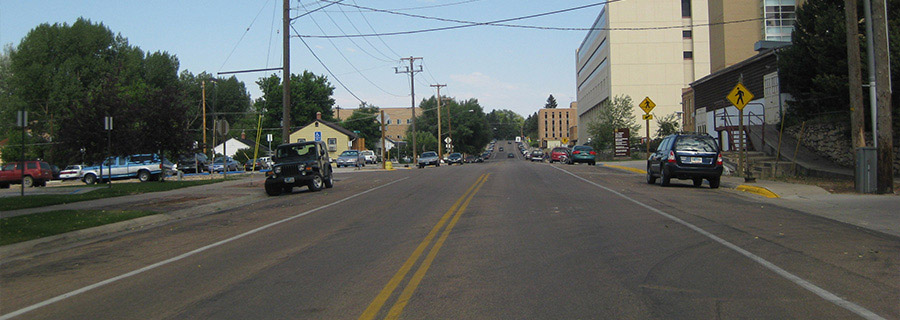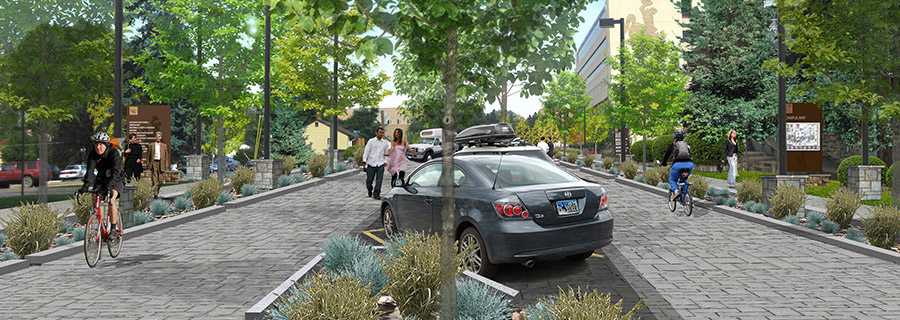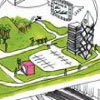


Green infrastructure may be defined as infrastructure that provides and promotes a network of natural systems within the urban environment and has the potential for energy generation. Traditionally the street has provided infrastructure for conveyance and delivery of water, energy and communications services. The street also has provided for collection and conveyance of storm water and sanitary sewage for disposal elsewhere through underground pipes and underground and overhead conduits. Recently in cities and towns across America, a movement to relook at street infrastructure has been growing. Green infrastructure is based on the principals of Low Impact Development (LID), and focuses on environmentally friendly approaches of natural ecosystem health, especially storm water management.
Green infrastructure can be implemented at a range of scales -- from regional scale to streetscape and site design. In the urban setting, it maybe most effective as part of a network of systems connected to established green spaces. This topic aims to expand the applications of green infrastructure with the goal of moving streets beyond passive conveyance systems to active roles in generating energy and transforming waste into useable products. This topic will explore opportunities to strengthen natural ecosystem cycles and environmentally friendly storm water management in our streets.
Why Green Infrastructure on the Street
Green infrastructure provides one of the greatest opportunities for streets and cities to achieve the goal of sustainabillity. Introducing natural processes for handling water and waste as well as capturing and reusing energy from the sun and wind has a number of advantages and benefits in a streetscape.
Adding plants and trees into the streetscape and reducing the amount of hardscape can aid in microclimate control and reduce the urban heat island effect, lowering energy demands from nearby homes and businesses. Improved air quality and providing habitat for animals, such as native pollinators or migratory songbirds, are benefits as well. Similarly, appropriate use of other planting materials, such as mulch, can help hold water and keep roots cool in plants and trees, especially in more arid climates where limiting water use is critical during warm seasons.
Capturing and reusing rainwater, slowing and cleaning storm water, providing additional storm water capacity, and preventing sewer overflows during large rain events results in cleaner and healthier watersheds. It allows for groundwater recharge, aquatic habitat protection and enhancement, and conservation of an important and increasingly scarce resource – water. In addition, storm water reuse and pollutant removal are being provided by space-saving above-ground and below-ground landscape devices.
Active green infrastructure, such as capturing solar and wind energy, can lower utility costs for local residents and businesses. In addition, active green infrastructure provides resiliency and self-sufficiency at a street or neighborhood level. Generating energy from a clean renewable source (i.e. the sun) — versus burning non-renewable, high carbon footprint fossil fuels — contributes to mitigating global climate change.
In addition to environmental advantages, localized and efficient green infrastructure also provides a multitude of economic and social benefits. To reduce wear and tear on aging pipe infrastructure, and in the long run, save on maintenance and replacement costs. Moreover, since most green infrastructure systems are visible and above ground, they can actively engage and educate the pubic about the benefits of creating environmentally friendly infrastructure systems.
Redefine role of infrastructure and create infrastructure systems that:
- View infrastructure elements as valuable resources that can contribute to the streetscape and provide necessary treatment at the street site.
- Conserve existing resources and actively mitigate negative impacts of streets.
- Aggressively generate energy and revenue.
- Prevent over-engineering of individual infrastructure elements.
- Promote economic development through reduced maintenance and generation of jobs and revenue.
- Maintain the street as a conduit for existing utilities while expanding green infrastructure.
- Design for both the local and regional watershed context.
Green infrastructure should be designed to promote a diversity of street activities including but not limited to:
- Harvesting rain water
- Harvesting gray water
- Generating solar and kinetic energy
- Storing heat, energy, and water
- Treating water, air, and soil
- Supplying energy and water
- Recycling and reusing resources
- Sourcing materials
- Growing and decomposing chemical and organic material
- Cycling nutrients
- Sequestering carbon
- Providing habitat
- Reducing heat gain
Green Infrastructure can be categorized according to infrastructure management systems and energy sources:
Materials Management Systems create and source materials in sustainable manner by:
-
Water systems include storm water systems and water conservation systems:
-
Storm Water Systems manage storm water by:
- Decreasing runoff rate and volume.
- Increasing the potential for filtering treatment and infiltration into the groundwater through landscaping and permeable paving. Popularly known as green streets, this system is increasingly embraced by towns and cities, especially those with combined sewer and storm water systems. In situations where infiltration is not feasible, tree box filters and other high-flow bioretention systems treat storm water systems before returning it to the system and the receiving waters.
- Water Conservation Systems conserve water by:
- Conserving and minimizing the use of water by harvesting rainwater and storm water for use for irrigation.
- Using efficient, water conserving irrigation systems such as drip irrigation.
- Xeriscaping and using drought tolerant planting.
-
Storm Water Systems manage storm water by:
-
Energy management systems generate and conserve energy. This is done in a number of ways including:
- Capturing and generating power from the sun, wind and kinetic energy. Kinetic energy is electricity generated through the weight and momentum of decelerating traffic and distributed electricity can be used to power streetlights, stoplights, and household appliances, and to cool/heat buildings and roads. It is an emerging technology
- Utilizing solar and wind energy to create electricity
- Managing heat gain by minimizing heat island effect in urban centers through the use of planting, etc
- Sequestering carbon
- Growing of materials such as bamboo that can be grown in the street
- Composting waste and recyclable materials to generate new materials
-
Materials management systems create and source materials in sustainable manner by:
- Growing of materials, such as bamboo, that can be grown in the street.
- Composting waste and recycling materials to generate new materials.
- Waste management systems recycle and reduce waster such as sewage.
- Habitat systems conserve and develop natural habitat for wildlife including pollinators, birds, etc.
Trees are a common element in most of the systems. Besides reducing heat island effect and storm water flows, they also increase natural habitat and property values.
A combination of elements and amenities are essential to the design of green infrastructure. This includes but is not limited to:
- Trees and vegetation
- Storm water planters, including inlet/outlet and overflow mechanisms, etc.
- Rain gardens
- Bioswales
- Subsurface storm water storage structures
- Surface storm water storage structures
- Pervious pavements
- Water efficient irrigation such as drip irrigation systems, smart controllers, etc.
- Solar power collection structures
- Windmills/turbines
- Kinetic structures/regenerative braking systems
- Power distribution systems
- Soil, mulch, etc.
- Art
- Gathering area for communal activities
- Interpretive elements, such as signage


